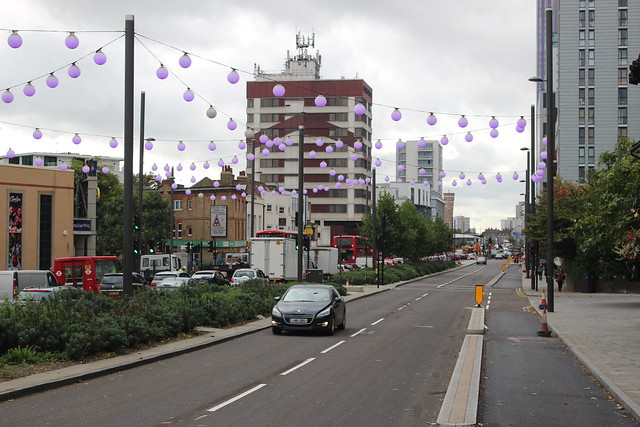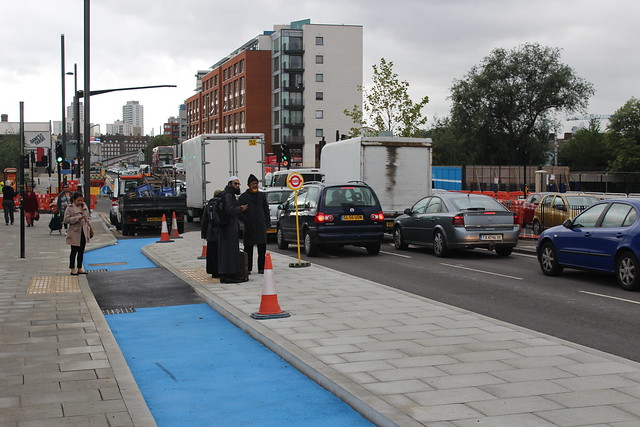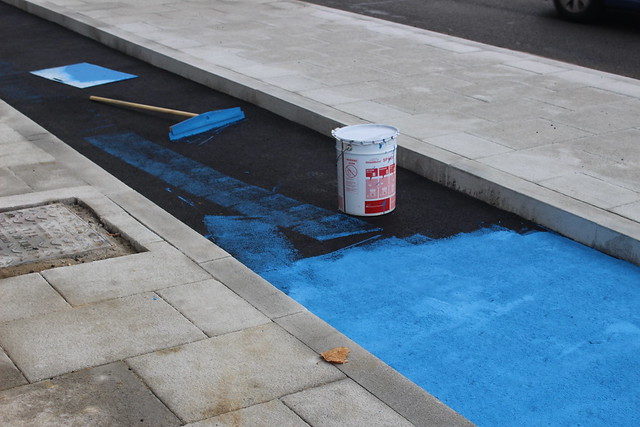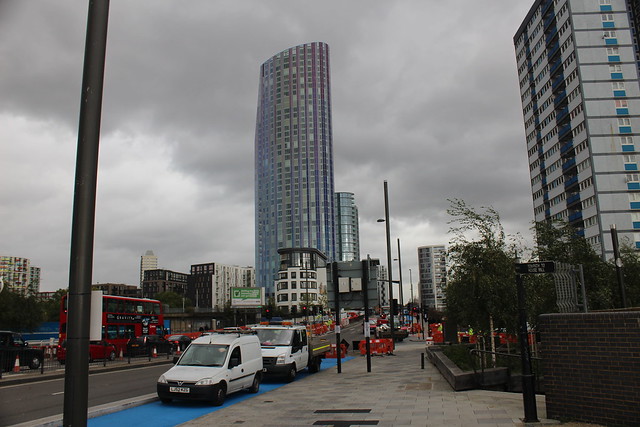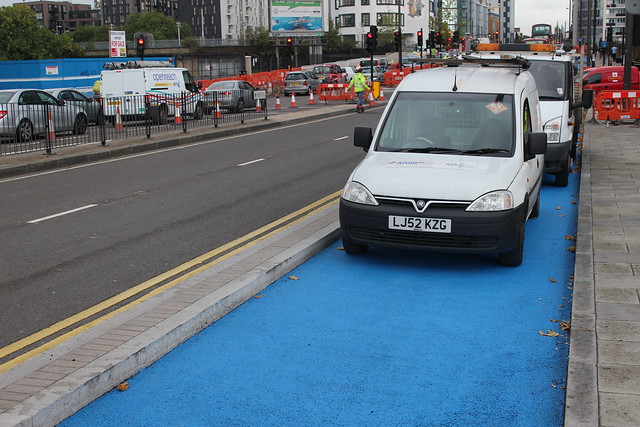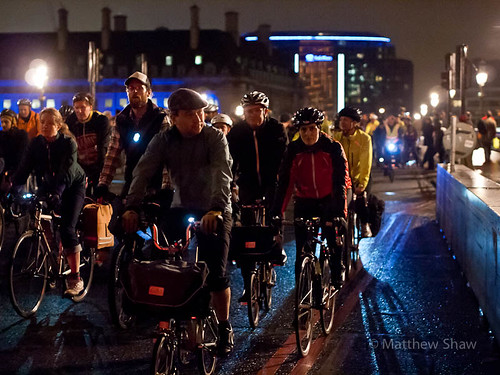Mark from As Easy As Riding a Bike blog tweeted a screen grab from Streetview recently of a newly painted bike lane in Horsham with the caption "Where that Department for Transport 'cycling money' is going. Brand new (2014) cycle 'infrastructure' painted in Horsham with Local Sustainable Transport Fund cash". It doesn't take a rocket scientist - let alone a road engineer - to work out that this is crap:
This shouldn't just make cyclist's blood boil. Not only is at best unusable and at worst downright dangerous, it's also a complete waste of tax payer's cash; something we are frequently reminded is in short supply these days.
However Horsham is not alone in splashing the cash (and the paint) around. Here's a shot I recently took in London's shiny new Olympic Park. This road layout is little more than a year or two old, and yet contains poorly painted sub-standard bike lanes which really help no one and serve no purpose:
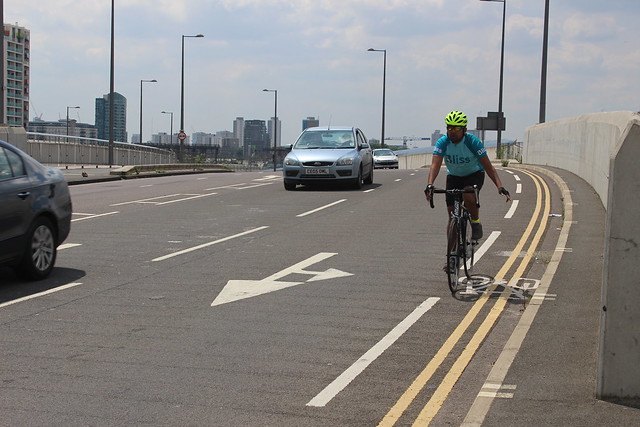
There's a faction of cycle advocates who would say it is not worth asking for cycle infrastructure at all, because all you get is nonsense like this. I can empathise with their position - the internet is filled with pages and pages of examples just as bad as this (or worse).
I've argued before that you need three things to make successful cycling cities:
And in the above cases I would strongly argue that it is the latter - design knowledge - which is lacking. There are plenty of road engineers out there who don't have a clue how to accommodate cyclists in their designs, but there are plenty more who would like to do so but are nervous from straying from the manual.
In UK road design circles innovation cowers in the shadow of liability, perhaps understandably when you consider that it is people's safety potentially at stake. As a consequence most of the space between buildings is filled in like a "Paint by Numbers" picture, fitting in whatever the manual says is appropriate.
Busy road with lots of vehicles? There's a pre-defined solution for that.
Quiet cul-de-sac with heavy pedestrian activity? There's a pre-defined solution for that, too. Call it "tick box urbanism", if you like.
The trouble is that most streets take a few years to get from the drawing board to reality, and in that time I would argue the aspiration of cycle campaigners has evolved whilst the guidance has struggled to keep up. In just a few short years in London we've gone from a situation where campaigners (and campaigns) could not even decide whether they wanted cycle provision or not, to a much broader consensus with far more ambitious aims. The London Cycling Campaign and others are now asking for - and getting - high quality, European-style separated infrastructure.
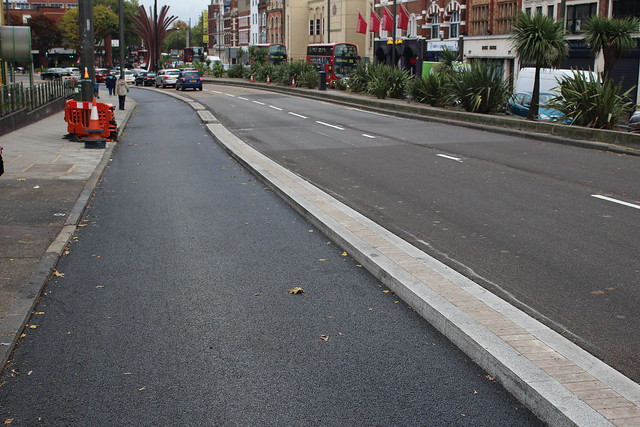
Transport for London have been quick to get their design skills up to date (see the Cycle Superhighways proposed for central London and the construction work currently ongoing around the Oval) whereas some of our local borough authorities are much further behind the curve.
And here's the trap. For those behind the times who are still following guidelines to the letter, there's a real policy lag. As has been remarked elsewhere, not all of the guidelines designers and engineers are employing are particularly effective at prescribing environments suitable for cyclists of all ages and abilities. Whilst there has been much in recent years to help make streets more attractive, there has been less about improving the actual subjective experience of riding a bike.
This policy lag - the inability of the paperwork to keep up with the aspiration - will ensure that for every fantastic new cycle track built over the next few years there's going to be plenty of crap, as well.
Further reading:
Rachel Aldred: what's wrong with place and movement hierarchies?
As Easy As Riding a Bike: when will design guidance think of cycling as something for all?
A View From The Cycle Path: 3 types of Cycle Safety
Share
This shouldn't just make cyclist's blood boil. Not only is at best unusable and at worst downright dangerous, it's also a complete waste of tax payer's cash; something we are frequently reminded is in short supply these days.
However Horsham is not alone in splashing the cash (and the paint) around. Here's a shot I recently took in London's shiny new Olympic Park. This road layout is little more than a year or two old, and yet contains poorly painted sub-standard bike lanes which really help no one and serve no purpose:

There's a faction of cycle advocates who would say it is not worth asking for cycle infrastructure at all, because all you get is nonsense like this. I can empathise with their position - the internet is filled with pages and pages of examples just as bad as this (or worse).
I've argued before that you need three things to make successful cycling cities:
- Political Will
- Money
- Design knowledge
And in the above cases I would strongly argue that it is the latter - design knowledge - which is lacking. There are plenty of road engineers out there who don't have a clue how to accommodate cyclists in their designs, but there are plenty more who would like to do so but are nervous from straying from the manual.
In UK road design circles innovation cowers in the shadow of liability, perhaps understandably when you consider that it is people's safety potentially at stake. As a consequence most of the space between buildings is filled in like a "Paint by Numbers" picture, fitting in whatever the manual says is appropriate.
Busy road with lots of vehicles? There's a pre-defined solution for that.
Quiet cul-de-sac with heavy pedestrian activity? There's a pre-defined solution for that, too. Call it "tick box urbanism", if you like.
The trouble is that most streets take a few years to get from the drawing board to reality, and in that time I would argue the aspiration of cycle campaigners has evolved whilst the guidance has struggled to keep up. In just a few short years in London we've gone from a situation where campaigners (and campaigns) could not even decide whether they wanted cycle provision or not, to a much broader consensus with far more ambitious aims. The London Cycling Campaign and others are now asking for - and getting - high quality, European-style separated infrastructure.

How wide do you want your spanking new bike tracks?
Transport for London have been quick to get their design skills up to date (see the Cycle Superhighways proposed for central London and the construction work currently ongoing around the Oval) whereas some of our local borough authorities are much further behind the curve.
And here's the trap. For those behind the times who are still following guidelines to the letter, there's a real policy lag. As has been remarked elsewhere, not all of the guidelines designers and engineers are employing are particularly effective at prescribing environments suitable for cyclists of all ages and abilities. Whilst there has been much in recent years to help make streets more attractive, there has been less about improving the actual subjective experience of riding a bike.
This policy lag - the inability of the paperwork to keep up with the aspiration - will ensure that for every fantastic new cycle track built over the next few years there's going to be plenty of crap, as well.
Further reading:
Rachel Aldred: what's wrong with place and movement hierarchies?
As Easy As Riding a Bike: when will design guidance think of cycling as something for all?
A View From The Cycle Path: 3 types of Cycle Safety
Share





